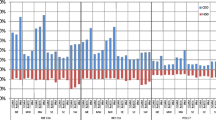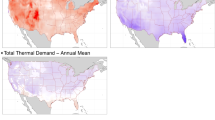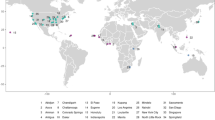Abstract
This study simulates the impacts of higher temperatures resulting from anthropogenic climate change on residential electricity consumption for California. Flexible temperature response functions are estimated by climate zone, which allow for differential effects of days in different temperature bins on households’ electricity consumption. The estimation uses a comprehensive household level dataset of electricity bills for California’s three investor-owned utilities (Pacific Gas and Electric, San Diego Gas and Electric, and Southern California Edison). The results suggest that the temperature response varies greatly across climate zones. Simulation results using a downscaled version of the National Center for Atmospheric Research global circulation model suggest that holding population constant, total consumption for the households considered may increase by up to 55% by the end of the century. The study further simulates the impacts of higher electricity prices and different scenarios of population growth. Finally, simulations were conducted consistent with higher adoption of cooling equipment in areas which are not yet saturated, as well as gains in efficiency due to aggressive energy efficiency policies.





Similar content being viewed by others
Notes
Two closely related and in parts overlapping companion papers contain more detail on the weather data extrapolation. Aroonruengsawat and Auffhammer (2009) provides simulation results for the households in the low income CARE program. Aroonruengsawat and Auffhammer (2011) further explore the sources of heterogeneity in the response function due to differences in the characteristics of the population and housing stock.
After removing outlier bills, we compared the population average daily consumption of bills with billing cycles ranging from 25–35 days to the average daily consumption of bills for any length. The average daily consumption by climate zone in the subset of bills we sample from is roughly \(\frac{1}{10}\)th of a standard deviation higher than the mean daily consumption of the complete population including bills of any length.
References
Aroonruengsawat A, Auffhammer M (2009) Impacts of climate change on residential electricity consumption: evidence from billing data. California Energy Commission PIER Report CEC-500-2009-018-D
Aroonruengsawat A, Auffhammer M (2011) Impacts of climate change on residential electricity consumption: evidence from billing data. In: Libecap G, Steckel RH (eds) The economics of climate change: past and present. University of Chicago Press
Auffhammer M, Kellogg R (2011) Clearing the air? The effects of gasoline content regulation on air quality. Am Econ Rev 101(6):2687–2722
Baxter LW, Calandri K (1992) Global warming and electricity demand: a study of California. Energy Policy 20(3):233–244
Bureau of Economic Analysis (2008) Regional economic accounts. Washington, DC. www.bea.gov/regional/spi/default.cfm?series=summary
California Energy Commission (2005) Integrated energy policy report. Sacramento, California
Cayan D, Tyree M, Dettinger M, Hidalgo H, Das T, Maurer E, Bromirski P, Graham N, Flick R (2009) Climate change scenarios and sea level rise estimates for the California 2009 climate change scenarios assessment. California Energy Commission PIER Report CEC-500-2009-014-F
Cline WR (1992) The economics of global warming. Institute for International Economics, Washington
Crowley C, Joutz F (2003) Hourly electricity loads: temperature elasticities and climate change. In: 23rd US Association of Energy Economics North American conference
Deschênes O, Greenstone M (2011) Climate change, mortality, and adaptation: evidence from annual fluctuations in weather in the US. American Economic Journal: Applied Economics, 3(4): 152-185
Energy Information Administration (EIA) (2008) State energy data system. Washington, DC
Espey JA, Espey M (2004) Turning on the lights: a meta-analysis of residential electricity demand elasticities. J Agric Appl Econ 36(1):65–81
Fisher FM, Kaysen C (1962) A study in econometrics: the demand for electricity in the US. North Holland Publishing Company
Franco G, Sanstad A (2008) Climate change and electricity demand in California. Clim Change 87:139–151
Hanemann W (1984) Discrete/continuous models of consumer demand. Econometrica 52:541–561
Houthakker HS, Taylor LD (1970) Consumer demand in the United States: analyses and projections. Harvard University Press, Cambridge
Intergovernmental Panel on Climate Change (IPCC) (2000) Emissions scenarios. Cambridge University Press, Cambridge
Mansur E, Mendelsohn R, Morrison W (2008) Climate change adaptation: a study of fuel choice and consumption in the US energy sector. J Environ Econ Manage 55(2):175–193
Reiss PC, White WM (2005) Household electricity demand revisited. Rev Econ Stud 72:853–883
Rosenthal D, Gruenspecht H, Moran E (1995) Effects of global warming on energy use for space heating and cooling in the United States. Energy J 16:77–96
Sanstad AH, Johnson H, Goldstein N, Franco G (2009) Long-run socioeconomic and demographic scenarios for California. Prepared for the Public Interest Energy Research Program, California Energy Commission, CEC-500-2009-013-F
Schlenker W, Roberts M (2009) Nonlinear temperature effects indicate severe damages to US crop yields under climate change. Proc Natl Acad Sci US Am 106(37):15594–15598
Author information
Authors and Affiliations
Corresponding author
Rights and permissions
About this article
Cite this article
Auffhammer, M., Aroonruengsawat, A. Simulating the impacts of climate change, prices and population on California’s residential electricity consumption. Climatic Change 109 (Suppl 1), 191–210 (2011). https://doi.org/10.1007/s10584-011-0299-y
Received:
Accepted:
Published:
Issue Date:
DOI: https://doi.org/10.1007/s10584-011-0299-y




